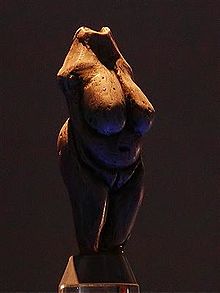| Venus of Moravany | |
|---|---|
 A Venus from Moravany nad Váhom, which dates back to 22,800 BC A Venus from Moravany nad Váhom, which dates back to 22,800 BC | |
| Material | Mammoth ivory |
| Created | 24,800 years ago |
| Discovered | 1930 Slovakia |
The Venus of Moravany (Slovak: Moravianska venuša) is a small prehistoric Venus figurine discovered in Slovakia in the early 20th century.
It was ploughed up in 1930 by farmer Štefan Hulman-Petrech near the village of Moravany nad Váhom in Slovakia.
It is made of mammoth tusk ivory and is dated to 22,800 BP, (the Gravettian).
A copy of this Venus currently resides in the Bratislava Castle exposition of the Slovak National Museum.
Origin of the 'Venus' name
Goddess of Beauty and Fertility
The Venus of Moravany received the name 'Venus' due to Upper Palaeolithic female figurines collectively being named "Venus figurines." This derives from the Roman goddess of beauty, Venus. The expression, "Venus", was first used in the mid-nineteenth century by the Marquis de Vibraye, who discovered an ivory figurine and named it La Vénus impudique or Venus Impudica ("immodest Venus"). Despite considerable diversity in opinion amongst archeologists and in paleoanthropological literature as to the function and significance of the figures, the name arises from the assumption that the figurines represent an ancient ideal of beauty. This perception is said to have derived from the fact that attention is directed to certain features common to most of the figurines, particularly emotionally charged primary and secondary sexual characteristics such as the breasts, stomachs and buttocks. However, somewhat ironically, the figurines majorly predate the mythological figure of Venus. As a result, critics, such as Vandewettering, have highlighted that this could be a reflection of Androcentric interpretations of the Venus figurines that, she suggests, were the starting point for archaeological understandings.
See also
References
- a.s, Slovesnká pošta. "POFIS - Catalog - Products - Art - Venus of Moravany". www.pofis.sk. Archived from the original on 2023-01-02. Retrieved 2023-01-02.
- A History of Slovakia: The Struggle for Survival by Stanislav J. Kirschbaum, p. 15
- Dixson, Alan F.; Dixson, Barnaby J. (2012-01-03). "Venus Figurines of the European Paleolithic: Symbols of Fertility or Attractiveness?". Journal of Anthropology. 2011: 1–11. doi:10.1155/2011/569120.
- Soffer, O.; Adovasio, J. M.; Hyland, D. C. (2000). "The "Venus" Figurines, Textiles, Basketry, Gender, and Status in the Upper Paleolithic". Current Anthropology. 41: 514. doi:10.1086/317381. S2CID 162026727. Archived from the original on 2022-10-07. Retrieved 2024-06-01.
- Vandewettering, Kaylea R. (2015). "Upper Paleolithic Venus Figurines and Interpretations of Prehistoric Gender Representations". PURE Insights. 4. Archived from the original on Oct 27, 2022 – via Western Oregon University.
| Venus figurines in prehistoric art | |
|---|---|
| Acheulean (disputed) | |
| Aurignacian | |
| Gravettian | |
| Magdalenian | |
| Related | |